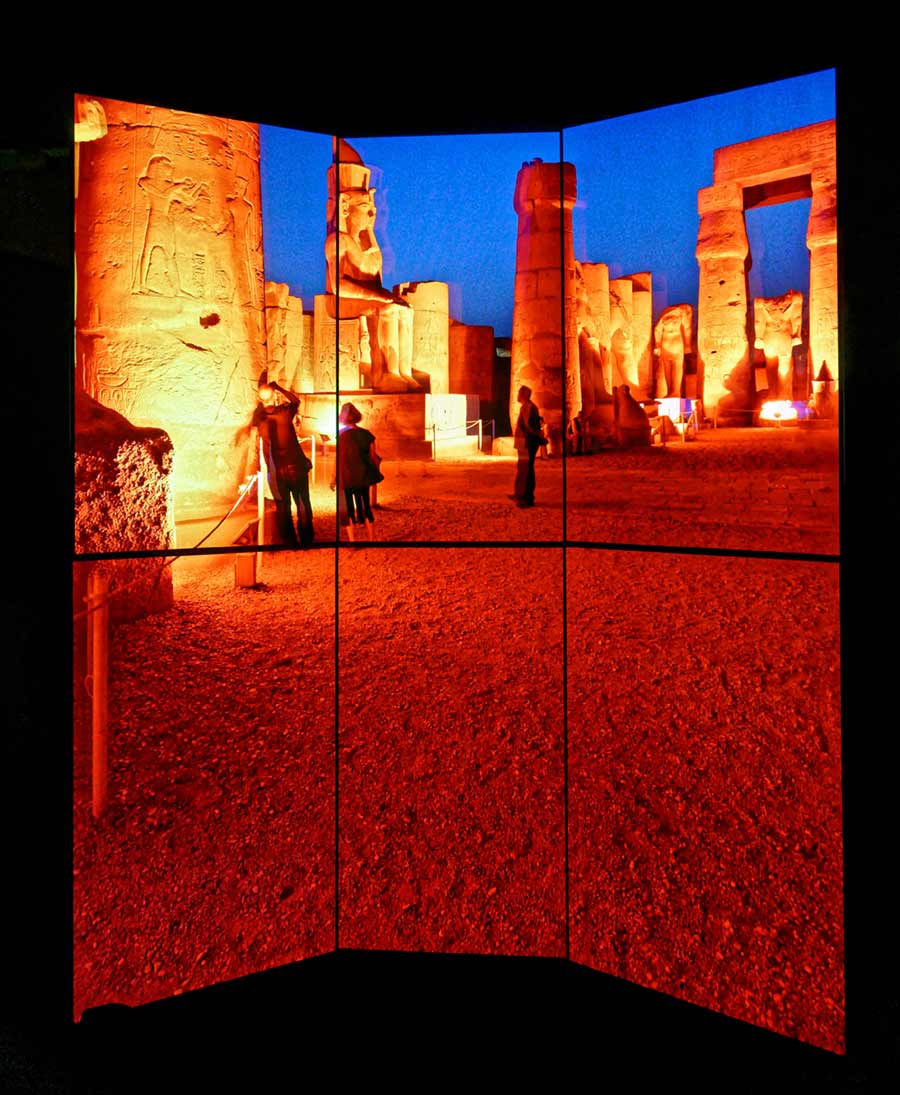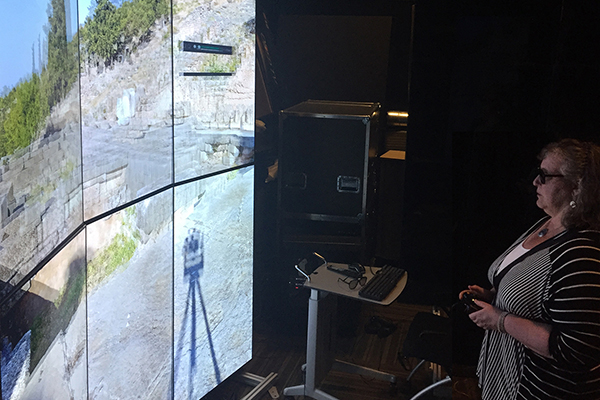New 3-D CAVEkiosk at UC San Diego Brings Cyber-Archaeology to Geisel Library
San Diego, October 31, 2016 — The University of California San Diego's iconic, futuristic spaceship of a building, Geisel Library, will unveil its first virtual-reality 3-D display system during a public reception on Monday, November 7 from 10 am to noon. The life-size CAVEkiosk will be open to the campus community and the public at large, but it will also allow researchers to analyze and visualize 3-D data from at-risk archaeological sites in Egypt, Turkey, Jordan, Israel, Greece, Morocco and Cyprus.

The Geisel Library kiosk is one of four kiosks planned for University of California campuses at San Diego, Berkeley, Los Angeles, and Merced. All are partners in a UC collaboration led by UC San Diego archaeologist Thomas E. Levy, a professor in the Department of Anthropology and director of the Qualcomm Institute’s Center for Cyber-Archaeology and Sustainability (CCAS).
The At-Risk Cultural Heritage and Digital Humanities project, funded by a UC President's Research Catalyst Award, leverages a 10-100 Gigabits-per-second network—the National Science Foundation-funded Pacific Research Platform (PRP)—to harness and preserve “big data” to ensure that endangered cultural heritage resources are preserved and safeguarded.
"We have just completed the first year of our Catalyst grant,” said Levy. “The installation of the 3-D CAVEkiosk in UC San Diego’s Geisel Library marks the completion of a major research goal of the project, so our team is very excited about that. In addition to catalyzing cyber-archaeology work and providing virtual reality-equipped network bandwidth with which UC scholars can collaborate, share, store and visualize at-risk cultural heritage data, members of the campus communities and visitors to the kiosks can “travel” to cultural heritage sites and explore them as if they were there.”
In addition to Geisel Library, 3-D kiosks are being installed at UC Merced’s Kolligian Library, UC Berkeley’s Phoebe Hearst Museum, and UCLA’s Fowler Museum—the latter two in 2017, said Levy. While the project’s most urgent goal is to preserve at-risk cultural heritage data and digital artifacts, the plethora of 3-D archaeological data will also be used to study, forecast and model the effects of human conflict, climate change, natural disasters and technological and cultural changes on these sites and landscapes.
“We are thrilled to have the 3-D CAVEkiosk in Geisel Library,” said Brian Schottlaender, UC San Diego’s University Librarian. “The Library is a place for discovery, collaboration, and creativity, and the hundreds of students who come to Geisel each day will be stimulated and inspired by what Tom Levy and his UC partners are trying to accomplish. I’m also pleased that the Library's Research Data Curation team is in on the ground floor of this important effort, and is preserving these vast amounts of data in our long-term digital preservation repository.”
The PRP, launched earlier this year, is spearheaded by UC San Diego computer science and engineering professor Larry Smarr, director of the California Institute for Telecommunications and Information Technology (Calit2). When complete, the PRP will function as a high-capacity data “freeway system,” and for the first time, will enable scholars at most of the West Coast research universities, national laboratories, and national supercomputer centers to share ultra-large data sets.

3-D virtual-reality system.
The CAVEkiosk technology—CAVE stands for “Cave Automated Virtual Environment”—was pioneered by Tom DeFanti, senior research scientist and scientific visualization leader with the Qualcomm Institute, the UC San Diego division of Calit2. The CAVEkiosk is the first large-scale 3-D immersive environment designed expressly for public engagement, so that members of the campus communities and the public can experience at-risk cultural heritage first-hand in libraries, museums and other public places.
The Catalyst grant project is a collaboration among archaeologists from four UC campuses: Tom Levy (UC San Diego), Benjamin Porter (UC Berkeley), Nicola Lercari (UC Merced), and Willeke Wendrich (UCLA).
“Each campus team has collected digital archaeology data from at-risk sites in the Middle East,” said Levy. “Last fall, I led a team to Israel and the Palestinian territories, to conduct research along the famous Kidron Valley, that has its origin near the Temple Mount—Haram al-Sharif in Jerusalem— and flows eastward through the Judean Desert to the Dead Sea. Along this drainage system is the famous Mar Saba Greek Orthodox monastery, dating to the 5th century AD. This is the second oldest continuously occupied monastery in the world. Our team used a helium balloon system to take hundreds of high-definition digital photographs from which to construct Structure-from-Motion (SfM) 3-D computer models of this beautiful site. Earlier this year, analysis of satellite imagery showed that the Islamic State (ISIS) destroyed a similar, 1,400-year-old monastery, St. Elijah (Dair Mar Elia in Arabic), in Iraq. While Mar Saba is not in immediate danger, our project highlights the importance of creating 3-D digital archives of important heritage sites around the world."
According to Levy, the Catalyst project employs a number of undergraduate students who are learning and honing valuable data science and VR technology skills. At UC San Diego, a team of students—Connor Smith, Kristin Agcaoili, and Anish Kannan—have been working with Levy’s co-PI, Qualcomm Institute research scientist Jurgen Schulze, to visualize the Mar Saba dataset for 3-D viewing in both the Geisel Library CAVEkiosk and in personal VR devices such as Oculus Rift and Google Cardboard. Added Levy: “The students are all members of the campus VR club and amazingly talented 20 year olds."
"Unfortunately, the Kidron Valley stream is totally polluted with raw sewage that is damaging both the cultural heritage and the natural environment. As it flows though both Israeli and Palestinian territory, I have a dream” said Levy. “I believe it may be possible to achieve small steps toward peace—through sewage! If we can use the tools of cyber-archaeology and scientific visualization to create VR platforms that engage all stakeholders in the area—through immersive VR like the CAVEkiosk—we can drive tourists, especially eco-tourists, to the Kidron Valley. If we can accomplish this we will create more economic value out of the invaluable and at-risk heritage sites such as Mar Saba.”
Media Contacts
Doug Ramsey/QI, (858) 246-0353, dramsey@ucsd.edu or Nikki Kolupailo/Library, 858-822-4803, nkolupailo@ucsd.edu, or Inga Kiderra/Social Sciences, ikiderra@ucsd.edu, 858-822-0661
Related Links
Center for Cyber-Archaeology and Sustainability
Qualcomm Institute
Geisel Library

